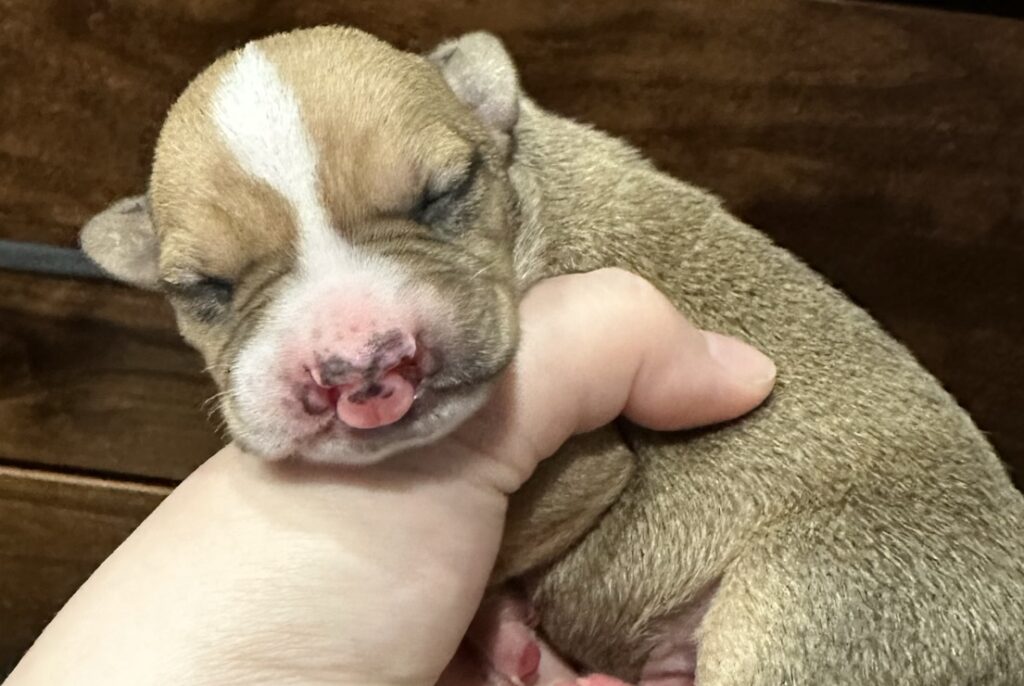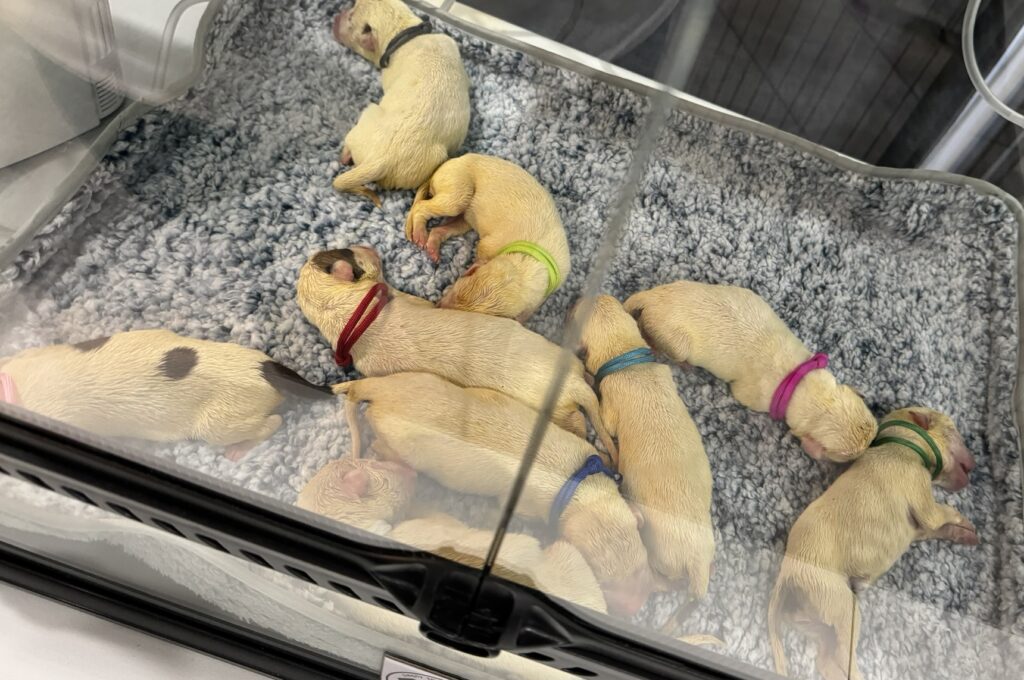Neonatal puppies are incredibly fragile, so being familiar with possible signs of a failing newborn puppy is incredibly helpful in being able to address issues sooner rather than later. Time really is of the essence when saving a weak newborn puppy!
A healthy newborn puppy will cry and squirm when handled and settle down when put back with its mother or in the warmth of its nest.1 They will twitch in their sleep, which is their primary activity (about 90% of the time), followed by eating and going potty. Their coats will be glossier, have better body tone (no signs of ribs), and feel dry and warm to the touch. Make sure you’ve already read our guide on how to take care of newborn puppies.

Signs of Fading Puppy Syndrome or Failure to Thrive
A newborn puppy who is not doing well is often described as failure to thrive or having fading puppy syndrome. They are generic diagnosis for newborn puppies who are weak and dying. However, the primary causes of neonatal death include: hypothermia (too cold), hypoglycemia (low blood sugar), dehydration, and sepsis.2 These can all be emergency situations, but sepsis is often the culmination of weight loss, increased vocalization, hypothermia, weak or failure to suckle, regurgitation/vomiting, and persistent diarrhea.3
There are several signs that can be apparent for a puppy that is not doing well, including the more obvious failure to gain weight, but regular visual and physical inspection of puppies is critical to seeing other signs early on. I recommend that these checks be done at least once daily for the first week, and then every other day unless there are any puppies that show signs they are weaker and those should be monitored more frequently or those signs should be addressed by human intervention.
The more signs shown, the more dire the situation is and the more critical human intervention is. There is not a lot that can be done for neonates, due to their age and size, but care includes bottle or tube-feeding, providing additional warmth, administering fluids, and giving antibiotics.

Sign #1: Failure to Gain Weight
Newborn puppies should gain approximately 10% of their body weight each day, and one of the first signs of a puppy that may need human intervention is when it cannot gain enough weight. This also includes pups that fail to gain weight or, worse, lose weight. Lack of milk or nutrition can result in hypoglycemia, easily brought on in newborn puppies as they cannot regulate their blood sugar yet.4
In mild cases, the pup may simply need to be placed on mom’s teat to get extra feedings or a feeding if the litter is larger and it has been pushed out of the way. If mom is not producing enough milk, supplemental bottle feedings may be enough to help pups gain weight consistently.
If mom is not nursing or is not producing milk, she should be seen by the vet to ensure her health, and the puppies should be bottle fed until mom is caring for them or starts to produce enough milk to feed her babies. Not all moms are maternal, which is something more often experienced in a rescue or shelter environment.
Pups should be fed using commercial, replacement formula to ensure that they are getting the proper nutrients. They can be fed using human infant bottles and nipples unless they’ve gotten too weak, which may necessitate tube feeding. However, tube feeding should only be done by experienced individuals due to the increased risk of aspiration and resulting aspiration pneumonia (which can be life-threatening).
Product Recommendation: Breeder’s Edge Foster Care GM is what I feed all of my newborn puppies who require bottle- or tube-feeding. The inclusion of Psyllium has a notable improvement on the consistency of newborn stool in my experience.
Sign #2: Crying Frequently
Newborn puppies should be sleeping for the majority of the time. They typically cry for a reason, so if you find you have a pup that cries out, mom or you should be trying to figure out what’s wrong. At this stage, puppies often cry because they’re hungry, cold, lost, or need to potty. If those are all addressed, you’ll need to look at whether they’re gaining weight, if they’re dehydrated, chilled, or going into sepsis.
Sign #3: Dehydrated
When the skin of a hydrated puppy is pinched, it should return quickly when released (less than two seconds), but if you see it slowly flattening back against the body, your pup is dehydrated. This could be the result of the environment may not have enough humidity in it, or it could not be getting enough milk. If you’re bottle feeding, this could also mean that the formula isn’t properly mixed and needs a bit more water added to it.
Dehydration can also be seen in the color of the newborn puppy’s urine, which should be nearly clear to pale yellow. If it is a darker yellow, then it is likely some dehydration is present.
You can give subcutaneous fluids to a newborn puppy if they are particularly dehydrated and also have symptoms such as lethargy, a weak suckle, or failure to gain weight. You need to warm the fluids up prior to giving them as you can chill a puppy otherwise. Subcutaneous fluids can be given at 1ml/30 grams.5
Sign #4: Lethargic or Weak Suckle
If a newborn puppy is weak in any way, whether that’s a puppy that doesn’t seem to move around much, won’t crawl to littermates or to mom, or does not latch or weakly latches to mom’s teat or a bottle, human intervention is necessary to give the pup a fighting chance. Puppies should twitch frequently while sleeping, so a sign of weakness is a puppy that is mostly still while sleeping.6
Human intervention is necessary if either of these signs are present. You will first need to take its temperature rectally with the ideal temperature being about 97 degrees.7 If the puppy is warm enough, it should be bottle or tube-fed. If it is not warm enough, it needs to be warmed up gradually before feeding.
If hypoglycemia is suspected, rubbing high-calorie, nutritional gel, onto the gums of the newborn can be done to help increase its blood sugar levels. Dextrose can be given intravenously but should be done through an emergency hospital or otherwise experienced personnel.
Product Recommendation: I use Tomlyn’s NutriCal for Puppies when I need a high-calorie, nutritional gel to address possible hypoglycemia or to increase calories and energy stores for a weak puppy.

Newborn puppies should have already been checked for cleft palates when born, but if you have not done so, check to make sure the weak suckle is not the result of a cleft palate, which is when the palate (roof of the mouth) has not closed and therefore has an opening that allows milk to get into the airway and fill the lungs. Cleft palate puppies must be tube-fed and monitored closely for signs of aspiration.
Sign #5: Chilled or Cold
Newborn puppies have trouble regulating their body temperature, which means they cannot keep themselves warm. It is critical that their environment be warm, both the ambient temperature (85 to 90 degrees) as well as having an adequate source of heat (like a heating pad or heat lamp).8 They should be able to move towards heat as well as move away from it if they are too warm.
As noted previously, newborn puppies should be around 97 degrees. A chilled neonate must be warmed gradually, and a chilled neonate should NOT be fed as it can lead to ileus, which results in regurgitation and aspiration.9 Aspiration results in the puppy getting milk into its lungs, which can cause aspiration pneumonia and make it difficult for it to breathe. Puppies struggling to breathe will need oxygen in order to survive.
High-risk puppies or a litter that is orphaned and has multiple high-risk individuals are best kept in an incubator in order to ensure proper humidity (40% to 55%) and temperature.10
Product Recommendation: The Puppy Warmer system is based on an incubator, which works well and is easy to clean, and can be attached to nebulizers or oxygen concentrators. Rescues that regularly take in weak newborn puppies or bottle babies should consider having an incubator and oxygen concentrator available to improve outcomes but also to minimize costs as oxygen delivered in a hospital setting is extremely expensive.

Sign #6: Mom Rejecting or Neglecting Puppies
If mom rejects a puppy or the entire litter, it could indicate that there is a deeper, underlying health issue, which requires human intervention immediately. Puppies need to nurse shortly after being born in order to receive colostrum, which helps give them the immunity they need as their systems are not yet developed for the first 10 days of life. Puppies can only absorb colostrum in the first 24 hours of life but this can begin decreasing as early as four hours after birth.11
You will also want to consider whether mom has any health issues, such as retaining a placenta or puppy after birth, or experiencing issues with milk production. Moms will reject chilled puppies, too, which is why keeping puppies warm is so important!
The signs above should be taken seriously, monitored aggressively, and it’s better for you to intervene sooner rather than later because there is no time to waste when it comes to saving a newborn puppy from dying. The longer a newborn puppy has been experiencing the above signs, the harder it may be to bring them back from the brink of death, especially if they’ve been chilled too long or are in septic shock.
There are not a lot of treatments available for dying newborn puppies; most include supportive care, such as intravenous fluids, incubation, and oxygen. Broad-spectrum antibiotics that are safe for neonates can be given if appropriate. Anyone expecting to care for newborn puppies should be prepared to provide basic supportive care such as bottle or tube-feeding and administering fluids or calorie gel.
Sometimes, despite early intervention and our best efforts, a newborn neonate will not make it. This is the hard part about taking care of newborn puppies, but without our intervention, they would not have even had a chance to survive.
Footnotes
- Davidson, A. P. (2022, December 5). Management of the Neonate in Dogs and Cats. Merck Veterinary Manual. https://www.merckvetmanual.com/management-and-nutrition/management-of-the-neonate/management-of-the-neonate-in-dogs-and-cats#Husbandry-in-the-First-Days-of-Life_v14493025 ↩︎
- 4 Main Causes of Newborn Puppy Illness and Death. (2023, February 16). Revival Animal Health. https://www.revivalanimal.com/learning-center/4-main-causes-of-newborn-puppy-illness-and-death ↩︎
- Simermeyer, L. (2020, July 3). Neonatal nursing care for high-risk puppies and kittens. DVM 360. https://www.dvm360.com/view/neonatal-nursing-care-for-high-risk-puppies-and-kittens ↩︎
- Davidson, A. P. (2022, December 5). Management of the Neonate in Dogs and Cats. Merck Veterinary Manual. https://www.merckvetmanual.com/management-and-nutrition/management-of-the-neonate/management-of-the-neonate-in-dogs-and-cats#Immunity_v14493093 ↩︎
- Simermeyer, L. (2020, July 3). Neonatal nursing care for high-risk puppies and kittens. DVM 360. https://www.dvm360.com/view/neonatal-nursing-care-for-high-risk-puppies-and-kittens ↩︎
- Simermeyer, L. (2020, July 3). Neonatal nursing care for high-risk puppies and kittens. DVM 360. https://www.dvm360.com/view/neonatal-nursing-care-for-high-risk-puppies-and-kittens ↩︎
- Fitzgerald, K. T., & Newquist, K. L. (2011). Husbandry of the Neonate. Small Animal Pediatrics, 44–52. https://doi.org/10.1016/B978-1-4160-4889-3.00006-1 ↩︎
- Davidson, A. P. (2022, December 5). Management of the Neonate in Dogs and Cats. Merck Veterinary Manual. https://www.merckvetmanual.com/management-and-nutrition/management-of-the-neonate/management-of-the-neonate-in-dogs-and-cats#Warmth_v14493028 ↩︎
- Fitzgerald, K. T., & Newquist, K. L. (2011). Husbandry of the Neonate. Small Animal Pediatrics, 44–52. https://doi.org/10.1016/B978-1-4160-4889-3.00006-1 ↩︎
- Davidson, A. P. (2022, December 5). Management of the Neonate in Dogs and Cats. Merck Veterinary Manual. https://www.merckvetmanual.com/management-and-nutrition/management-of-the-neonate/management-of-the-neonate-in-dogs-and-cats#Warmth_v14493028 ↩︎
- Davidson, A. P. (2022, December 5). Management of the Neonate in Dogs and Cats. Merck Veterinary Manual. https://www.merckvetmanual.com/management-and-nutrition/management-of-the-neonate/management-of-the-neonate-in-dogs-and-cats#Immunity_v14493093 ↩︎






